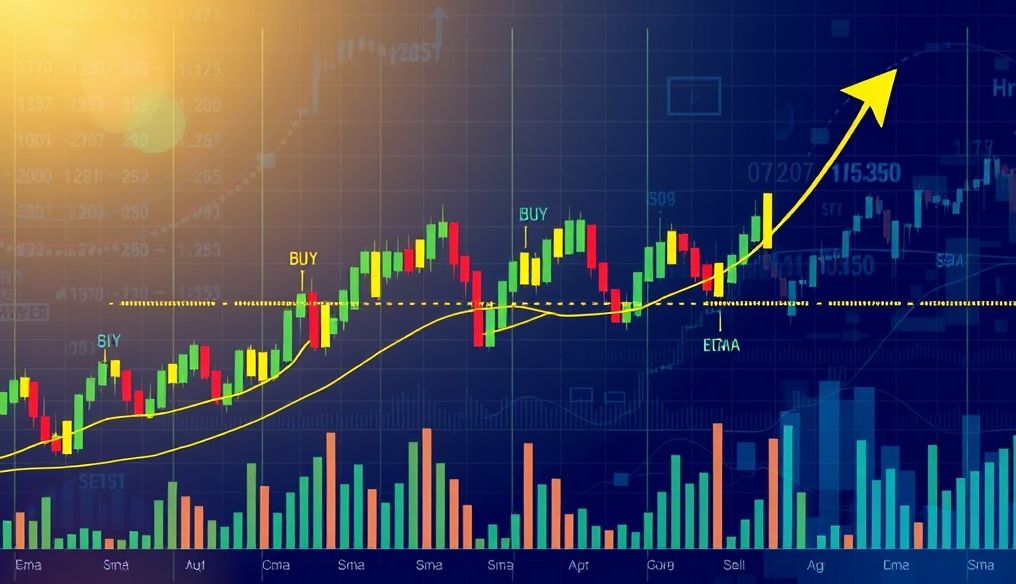المقدمة: فهم قوة المتوسطات المتحركة في التداول
تعتبر المتوسطات المتحركة من أهم الأدوات المستخدمة في التحليل الفني للأسواق المالية. فهي تساعد المتداولين على تحديد الاتجاهات الرئيسية للأسعار وتوقع حركتها المستقبلية. سواء كنت متداولًا مبتدئًا أو محترفًا، فإن فهم كيفية استخدام المتوسطات المتحركة يمكن أن يحسن بشكل كبير من أدائك.
تهدف هذه المقالة إلى تقديم دليل شامل حول استراتيجيات التداول باستخدام المتوسطات المتحركة، مع التركيز على كيفية تطبيقها بشكل عملي لتحقيق أرباح مستدامة.
الفصل الأول: ما هي المتوسطات المتحركة؟
تعريف المتوسطات المتحركة
المتوسط المتحرك هو مؤشر فني يحسب متوسط سعر الأصل المالي (مثل الأسهم، العملات، السلع) خلال فترة زمنية محددة. يتم تحديث هذا المتوسط باستمرار مع تحرك السعر، مما يخلق خطًا سلسًا يوضح اتجاه السعر.
أنواع المتوسطات المتحركة
- المتوسط المتحرك البسيط (SMA): يحسب المتوسط عن طريق جمع أسعار الإغلاق خلال الفترة الزمنية المحددة ثم قسمتها على عدد الفترات.
- المتوسط المتحرك الأسي (EMA): يعطي وزنًا أكبر للأسعار الأحدث، مما يجعله أكثر حساسية لتغيرات الأسعار الأخيرة.
- المتوسط المتحرك المرجح (WMA): يشبه المتوسط المتحرك الأسي، ولكنه يسمح بتحديد أوزان مختلفة لكل فترة زمنية.
يعتبر المتوسط المتحرك البسيط (SMA) أسهل أنواع المتوسطات المتحركة، بينما يعتبر المتوسط المتحرك الأسي (EMA) أكثر استجابة لتغيرات الأسعار.
الفصل الثاني: استخدامات المتوسطات المتحركة في التحليل الفني
تحديد الاتجاه
تعتبر المتوسطات المتحركة أداة قوية لتحديد اتجاه السوق. عندما يكون سعر الأصل أعلى من المتوسط المتحرك، يشير ذلك إلى اتجاه صعودي. وعلى العكس، عندما يكون السعر أقل من المتوسط المتحرك، يشير ذلك إلى اتجاه هبوطي.
تحديد مستويات الدعم والمقاومة
يمكن أن تعمل المتوسطات المتحركة كمستويات دعم ومقاومة ديناميكية. في الاتجاه الصعودي، قد يجد السعر دعمًا عند المتوسط المتحرك. وفي الاتجاه الهبوطي، قد يواجه السعر مقاومة عند المتوسط المتحرك.
توليد إشارات البيع والشراء
تستخدم العديد من استراتيجيات التداول المتوسطات المتحركة لتوليد إشارات البيع والشراء. على سبيل المثال، يمكن استخدام تقاطع متوسطين متحركين (أحدهما قصير الأجل والآخر طويل الأجل) لتحديد نقاط الدخول والخروج من الصفقات.
الفصل الثالث: استراتيجيات التداول باستخدام المتوسطات المتحركة
استراتيجية تقاطع المتوسطات المتحركة
تعتبر استراتيجية تقاطع المتوسطات المتحركة من أشهر استراتيجيات التداول. تتضمن هذه الاستراتيجية استخدام متوسطين متحركين بفترات زمنية مختلفة. عندما يتقاطع المتوسط المتحرك قصير الأجل مع المتوسط المتحرك طويل الأجل من الأسفل إلى الأعلى، فإن ذلك يعتبر إشارة شراء. وعلى العكس، عندما يتقاطع المتوسط المتحرك قصير الأجل مع المتوسط المتحرك طويل الأجل من الأعلى إلى الأسفل، فإن ذلك يعتبر إشارة بيع.
مثال: استخدام متوسط متحرك لمدة 50 يومًا ومتوسط متحرك لمدة 200 يوم. عندما يتقاطع المتوسط المتحرك لمدة 50 يومًا فوق المتوسط المتحرك لمدة 200 يوم، فإن ذلك يشير إلى بداية اتجاه صعودي محتمل.
استراتيجية المتوسط المتحرك كدعم ومقاومة
تعتمد هذه الاستراتيجية على استخدام المتوسط المتحرك كمستوى دعم أو مقاومة. عندما يكون السعر في اتجاه صعودي، يمكن استخدام المتوسط المتحرك كمستوى لدخول صفقات شراء عند ارتداد السعر عنه. وعندما يكون السعر في اتجاه هبوطي، يمكن استخدام المتوسط المتحرك كمستوى لدخول صفقات بيع عند ارتداد السعر عنه.
مثال: إذا كان السعر في اتجاه صعودي وكان المتوسط المتحرك لمدة 20 يومًا يعمل كمستوى دعم، يمكن للمتداولين البحث عن فرص شراء عندما يقترب السعر من هذا المتوسط المتحرك.
استراتيجية المتوسط المتحرك المتعدد
تتضمن هذه الاستراتيجية استخدام ثلاثة أو أكثر من المتوسطات المتحركة بفترات زمنية مختلفة. يمكن استخدام هذه المتوسطات لتأكيد الاتجاه وتحديد نقاط الدخول والخروج المحتملة.
مثال: استخدام متوسطات متحركة لمدة 20 يومًا، 50 يومًا، و 200 يوم. إذا كان السعر أعلى من جميع هذه المتوسطات، فإن ذلك يشير إلى اتجاه صعودي قوي. يمكن استخدام المتوسط المتحرك لمدة 20 يومًا لتحديد نقاط الدخول المحتملة.
الفصل الرابع: اختيار الفترات الزمنية المناسبة للمتوسطات المتحركة
يعتمد اختيار الفترات الزمنية المناسبة للمتوسطات المتحركة على عدة عوامل، بما في ذلك الإطار الزمني الذي تتداول فيه (يومي، أسبوعي، شهري) ونوع الأصل المالي الذي تتداوله. بشكل عام، تستخدم الفترات الزمنية القصيرة (مثل 10 أو 20 يومًا) للمتداولين الذين يبحثون عن فرص تداول سريعة، بينما تستخدم الفترات الزمنية الطويلة (مثل 50 أو 200 يوم) للمتداولين الذين يركزون على الاتجاهات طويلة الأجل.
نصيحة: قم بتجربة فترات زمنية مختلفة على الرسوم البيانية التاريخية لتحديد الفترات التي تعمل بشكل أفضل مع الأصل المالي الذي تتداوله.
الفصل الخامس: دمج المتوسطات المتحركة مع مؤشرات فنية أخرى
لتحسين دقة إشارات التداول، يمكن دمج المتوسطات المتحركة مع مؤشرات فنية أخرى، مثل:
- مؤشر القوة النسبية (RSI): يستخدم لتحديد ما إذا كان الأصل المالي في منطقة ذروة الشراء أو ذروة البيع.
- مؤشر الماكد (MACD): يستخدم لتحديد التغيرات في قوة الاتجاه.
- مؤشر ستوكاستيك (Stochastic Oscillator): يستخدم لتحديد مناطق ذروة الشراء والبيع بناءً على نطاق الأسعار.
مثال: يمكن استخدام تقاطع المتوسطات المتحركة كإشارة شراء، ولكن يجب تأكيد هذه الإشارة باستخدام مؤشر RSI للتأكد من أن الأصل المالي ليس في منطقة ذروة الشراء.
الفصل السادس: إدارة المخاطر في التداول باستخدام المتوسطات المتحركة
تعتبر إدارة المخاطر جزءًا أساسيًا من أي استراتيجية تداول ناجحة. عند استخدام المتوسطات المتحركة، من المهم تحديد مستويات وقف الخسارة وجني الأرباح المناسبة. يمكن استخدام المتوسطات المتحركة نفسها لتحديد هذه المستويات.
مثال: يمكن وضع وقف الخسارة أسفل المتوسط المتحرك مباشرة في حالة صفقات الشراء، وفوق المتوسط المتحرك مباشرة في حالة صفقات البيع.
الفصل السابع: أمثلة عملية من السوق العربي والعالمي
دعونا نلقي نظرة على بعض الأمثلة العملية من السوق العربي والعالمي لكيفية استخدام المتوسطات المتحركة في التداول:
- السوق السعودي: يمكن استخدام المتوسطات المتحركة لتحديد اتجاه سهم شركة أرامكو. على سبيل المثال، إذا كان سعر السهم أعلى من المتوسط المتحرك لمدة 200 يوم، فإن ذلك يشير إلى اتجاه صعودي طويل الأجل.
- سوق العملات الأجنبية: يمكن استخدام استراتيجية تقاطع المتوسطات المتحركة للتداول على زوج اليورو/دولار. يمكن استخدام متوسط متحرك لمدة 50 يومًا ومتوسط متحرك لمدة 200 يوم لتحديد نقاط الدخول والخروج من الصفقات.
- سوق الأسهم الأمريكية: يمكن استخدام المتوسط المتحرك كدعم ومقاومة للتداول على أسهم شركات التكنولوجيا مثل Apple أو Microsoft.
الفصل الثامن: الأخطاء الشائعة في استخدام المتوسطات المتحركة
يتعرض العديد من المتداولين لأخطاء شائعة عند استخدام المتوسطات المتحركة، مثل:
- الاعتماد على المتوسطات المتحركة فقط: يجب دمج المتوسطات المتحركة مع مؤشرات فنية أخرى وأدوات تحليل أساسي.
- استخدام فترات زمنية غير مناسبة: يجب اختيار الفترات الزمنية التي تتناسب مع الإطار الزمني للتداول ونوع الأصل المالي.
- عدم إدارة المخاطر بشكل صحيح: يجب تحديد مستويات وقف الخسارة وجني الأرباح المناسبة.
الفصل التاسع: نصائح لتحسين استراتيجيات التداول باستخدام المتوسطات المتحركة
- اختبر استراتيجياتك على الرسوم البيانية التاريخية: قبل تطبيق استراتيجية تداول جديدة، اختبرها على الرسوم البيانية التاريخية للتأكد من فعاليتها.
- استخدم حسابًا تجريبيًا: قبل التداول بأموال حقيقية، استخدم حسابًا تجريبيًا لممارسة استراتيجيات التداول الخاصة بك.
- كن صبورًا ومنضبطًا: التداول الناجح يتطلب صبرًا وانضباطًا. لا تتسرع في اتخاذ القرارات وتجنب التداول العاطفي.
الفصل العاشر: الخلاصة
تعتبر المتوسطات المتحركة أداة قوية في التحليل الفني ويمكن استخدامها لتحديد الاتجاهات وتوليد إشارات البيع والشراء. من خلال فهم كيفية استخدام المتوسطات المتحركة بشكل صحيح ودمجها مع مؤشرات فنية أخرى، يمكن للمتداولين تحسين أدائهم وزيادة أرباحهم. تذكر دائمًا أن إدارة المخاطر هي جزء أساسي من أي استراتيجية تداول ناجحة.
إخلاء المسؤولية: هذه المقالة هي لأغراض تعليمية فقط ولا تشكل نصيحة مالية. التداول في الأسواق المالية ينطوي على مخاطر عالية وقد لا يكون مناسبًا لجميع المستثمرين.



